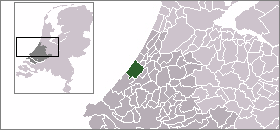Wassenaar
- For the multilateral export control regime, see Wassenaar Arrangement.
Wassenaar | |
|---|---|
Municipality | |
 Het Plein, the historical town square in Wassenaar, featuring the Dorpskerk | |
 | |
| Country | Netherlands |
| Province | South Holland |
| Area (2006) | |
| • Total | 62.50 km2 (24.13 sq mi) |
| • Land | 50.85 km2 (19.63 sq mi) |
| • Water | 11.65 km2 (4.50 sq mi) |
| Population | |
| • Total | 25,651 |
| • Density | 504/km2 (1,310/sq mi) |
| Source: CBS, Statline. | |
| Time zone | UTC+1 (CET) |
| • Summer (DST) | UTC+2 (CEST) |
| Website | www.wassenaar.nl |
Note: parts of this article have been translated from the Dutchversion of this page.
Wassenaar (population: 25,651 as of June 1, 2007) is a town in the western Netherlands, in the province of South Holland. A fairly affluent suburb of The Hague, Wassenaar lies 10 km (6 mi) north of that city on the N44 highway near the North Sea coast. The municipality covers an area of 62.50 km², of which 11.65 km² is covered by water. Inhabitants of Wassenaar are called Wassenaarders.
History
It is known that a 12th century Romanesque church in Wassenaar lies on the spot where the Northumbrian missionary Willibrord once landed in the Netherlands; the high dunes to the west were not formed until later.
Wassenaar long remained an unremarkable little town, known only as the home of the House of Wassenaer. It only began to gain notoriety in the 18th century when Louis Bonaparte ordered the construction of the Heerweg ("Lord Road") between The Hague and Leiden, which forms the current Rijksstraatweg. In approximately 1840, Prince Frederik had the De Paauw palace built, where he lived for many years; it now serves as the city hall of Wassenaar.
With the laying in 1907 of the railway between The Hague and Scheveningen, the course of which now forms the Landscheidingsweg, Wassenaar began to become a popular place for wealthier residents of The Hague to live.
The American World War II and Korean War general Haywood Hansell, who helped plan the Allied bombing offensive against both Germany and Japan, lived in Wassenaar in retirement from 1957 to 1966.
The Wassenaar Arrangement, a Post-Cold War era arms control convention, was signed here by forty member nations in May 1996.
Wassenaar today
Wassenaar is, as it has been since the days of Prince Frederik, an official residence: Willem-Alexander, Prince of Orange, his wife Princess Máxima of the Netherlands and their daughters Princess Amalia, Princess Alexia and Princess Ariane, live in the villa Eikenhorst at the estate De Horsten in Wassenaar; Princess Alexia was baptized at the Romanesque church in Wassenaar.

In addition, several ambassadorial residences are located here, including those of Canada and South Korea. In general, there is a large expatriate community of diplomats and businesspeople in Wassenaar, largely due to its proximity to both the international organisations and embassies in The Hague and to several international schools, including the American School of the Hague and the British School in the Netherlands. The Netherlands Institute for Advanced Study (NIAS) is also based in Wassenaar; each year, it provides research time, space and support for foreign and Dutch scholars.
Some remnants of the Atlantic wall are to be found on Wassenaar's beach; nearly a thousand meters of underground walled tunnels connect five bunkers. The network now serves as a bat sanctuary and is open to visits in the summer. The theme park Duinrell and the race track Duindigt, the only remaining grass race track in the Netherlands, are here as well.
Wassenaar has always enjoyed good relations with the neighboring town of Voorschoten. They have had a shared history from time immemorial; for example, the House of Wassenaer historically resided in the Kasteel Duivenvoorde in Voorschoten.
Notable people from Wassenaar
- Theo van Gogh (1957-2004), filmmaker, director, and columnist
- Thom Hoffman (b. 1957), actor and photographer
- Nico van der Voet (b. 1944), water polo player
- Konrad Bartelski (b. 1954), skier, lived in Wassenaar for a number of years



